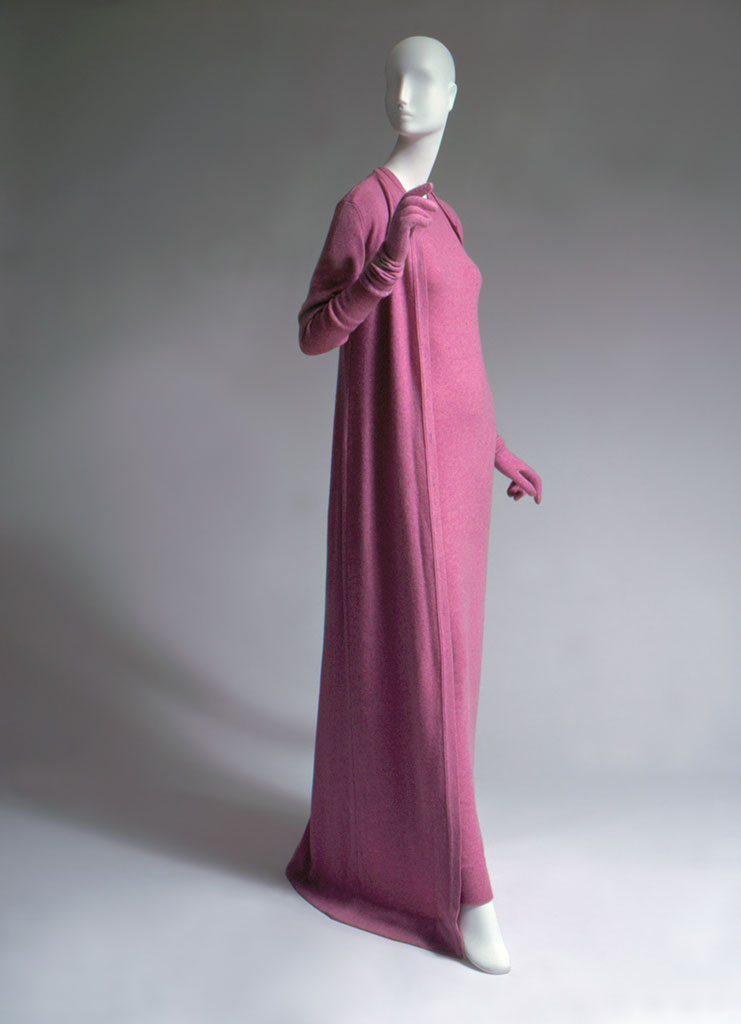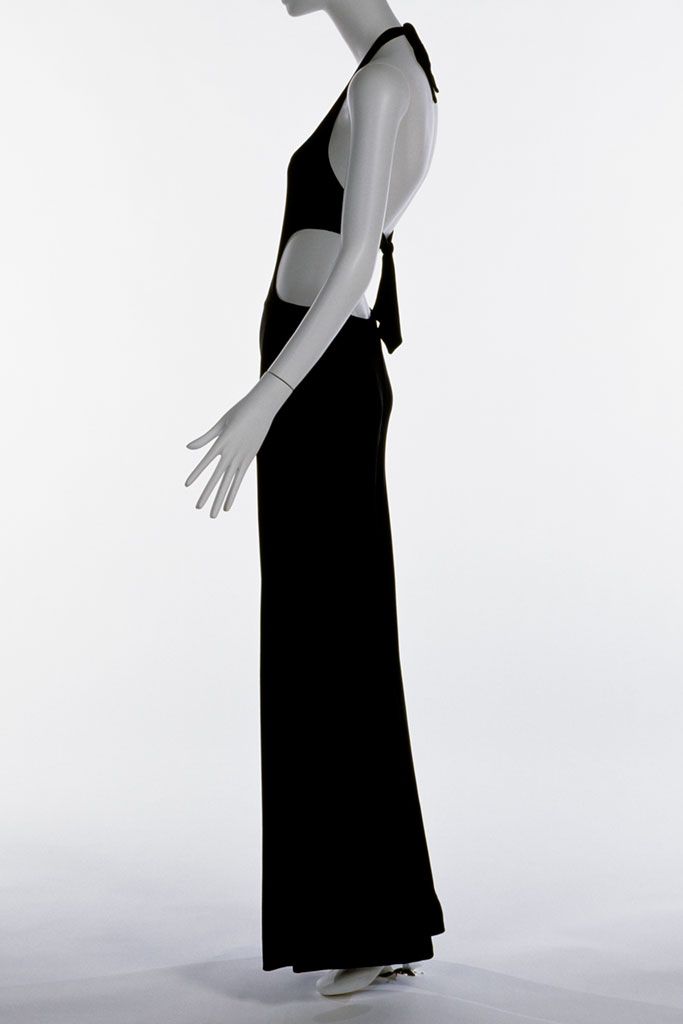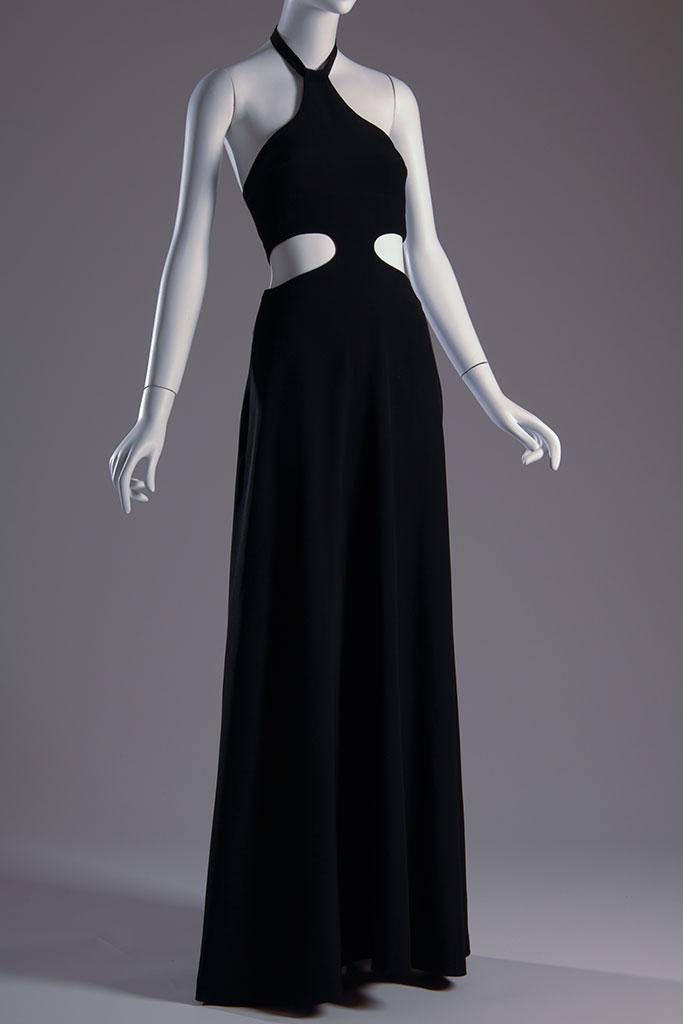Historicism: Halston
- By The Museum at FIT
- In Object post
- On 15 Apr | '2015
Today we bring you an excerpt from our Special Exhibitions Gallery on Halston + historicism:
Halston’s use of historical elements to create new collections was sparing. Rather than re-interpret the designs of those who came before him, he made subtle allusions to those designers whose work he most admired. He was inspired by body-revealing activewear and the sinuous, bias-cut gowns of Madeleine Vionnet from the 1930s, while primary influences from the 1940s included the cashmere sweater sets of Mainbocher and the ingenious ties and closures employed by Claire McCardell.

Halston evening ensemble, purple cashmere, c. 1973, USA, 88.29.2, gift of Elizabeth Pickering Kaiser
Like his predecessors, Halston rejected standard fit techniques, such as darts and waistbands; wherever possible, he removed linings and inner structures, as well as buttons and notions. He also painstakingly modified a small number of basic items that were worked and reworked until their proportions and fabrications became perfect.
Curator Patricia Mears reveals Halston’s approach to design in the book Yves Saint Laurent + Halston: Fashioning the 70s:
Halston also differentiated himself from his contemporaries (and most designers today), in that he had a strong belief in the process of evolution. Rather than espousing the slash-and-burn practice in which designers embraced and then quickly discarded trends, Halston painstakingly modified a small number of basic items that were worked and reworked until their proportions and fabrications were perfect.

(left) Halston, pajama set, silk crepe de chine, c. 1976, USA, 78.57.41, gift of Ethel Scull
(right) Halston, tunic, silk satin, 1976, USA, 84.11.2, gift of Sue Christine Hartman
Halston’s evolutionary process connected him to the work of past couturiers. Mears wrote that by “refreshing and updating the silhouettes, integrating more comfort, and blurring the lines between activewear, daywear, and evening clothes,” Halston created garments that were perfect for the modern jet-set lifestyles of the 1970s.
Halston often refined elegant examples of historic fashions, and as Mears noted, “one of the great aspects of his success was his ability to balance beauty and modernity.” The 1930s lounging pajama was one such example:
Halston modernized and formalized the 1930s pajama, an ensemble that was to be worn in either a casual, sporty environment or at home. On top, although there were numerous variations, Halston usually crafted his tunic with a set-in collar, deep V-neckline, long sleeves, a curved hem that covered the hips, and a slightly narrowed waist. His pants were svelte but not tight. By 1976, most sources record that Halston was cutting all such pants, especially those made of silk satin or crepe, on the bias. This technique insured a slim fit but also a certain degree of elasticity.

Halston jumpsuit, black silk jersey, c.1976, USA, 79.66.40, gift of Ethel Scull.
Halston’s “swimsuit dress” is one of many dresses he created that were inspired by halter neck dresses of the 1920s-30s and activewear from the 1930s. Halston channeled the elegance and freedom of movement found in these historical styles and re-contextualized them, making them suitable for the fast-paced lifestyles of the 1970s. Mears wrote that “While similar exposure of the body did exist in swimwear during the 1930s, Halston expanded the amount of skin on view, and took the idea from the beach to the ballroom.” The halter neck silhouette, bias-drape, and side cut-outs in Halston’s “swimsuit dress” are features similar to those found in this Madame Grès evening dress from c.1966-68. Mears connects and contrasts the work of Halston and Grès in an earlier post.

Madame Grès evening dress, black silk, c.1966-68, courtesy of Hamish Bowles. From the book Madame Grès: Sphinx of Fashion.
Love this post? Share it on social media with the links below. The exhibition is on view through the end of the week, April 18, 2015—don’t miss it! Share your experience using #YSLhalston.
—MM



 The Halstonettes
The Halstonettes